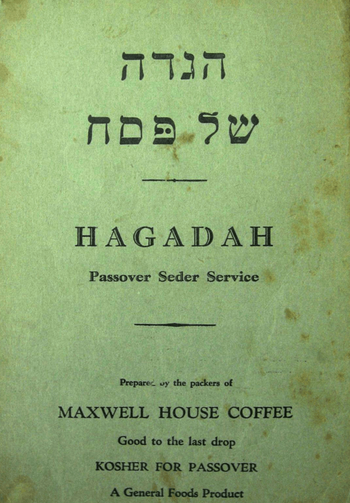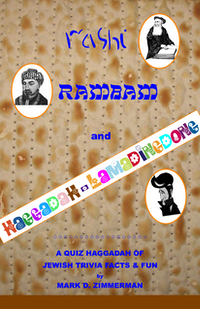The most popular haggadah in American history is the Maxwell House Haggadah, which the company has been distributing for free (with purchases of Maxwell House coffee) since 1932. More than 50 million copies have been given away worldwide since then, and they even had a place at the table of the White House seder hosted by President Barack Obama. What is the background story of Maxwell House’s decision to market their coffee by producing a Passover haggadah?

Maxwell_House_1933_Haggadah_cover is in the public domain.
A. The most popular coffee among Jews of New York in the early twentieth century was Nescafé, made by a Jewish-owned company. In fact, the name Nescafé was created by combining the Hebrew word Nes, meaning Miracle with café, for coffee. In 1919, Maxwell House Coffee was the upstart competitor created by a Russian immigrant, Max Schilkofsky of Brooklyn. He was constantly trying to find a way to overcome Nescafé’s prominence in the marketplace, when, during the early spring of 1931, his wife told him to stop at the Jewish bookseller and purchase some haggadahs, as Passover was approaching and they needed additional copies for their expected large crowd. As he perused the haggadahs and made his purchase, he had the brainstorm that giving away free haggadahs could be the marketing ploy that would work. He connected with a publishing company and produced the first Maxwell House haggadah the following year.
B. While Maxwell House was a well-known brand of coffee within the Jewish community, as it was certified kosher, it was not typically served at seder meals because many people drank their coffee with milk, which could not be done at a meal which was almost always a meat meal (brisket being the most popular main course). In 1928, Rich Products came out with a new product, non-dairy creamer. With this invention, the people at Maxwell House finally saw an opening for their product at Passover. They initially placed ads in the Forverts newspaper showing pictures of their coffee can alongside a picture of the Rich non-dairy creamer product and a notation that Rabbi Shmuel Krinsky of Congregation Anshe Chesed on the Lower East Side had certified both products to be kosher for Passover. As a further effort to increase sales of Maxwell House coffee, the company began distributing free haggadahs with purchases of their coffee. Rich’s originally distributed the Maxwell House haggadah with sales of their non-dairy creamer as well, but discontinued this practice after a couple of years because of pressure from other coffee companies.
C. The idea for a haggadah to be distributed for free was first envisioned by the Hebrew Immigrant Aid Society, working with Eastern European immigrants who were settling in New York. The aid organization would typically give haggadahs to new immigrants (among many items of support they would provide), but as the number of immigrants dramatically increased, they needed a way to fund this project. Someone from HIAS approached the people at Maxwell House and asked them to sponsor the printing of a haggadah. The first haggadah was printed and given out by HIAS in 1931, noting on the cover that it was paid for by Maxwell House Coffee. The following year, Maxwell House asked if they could print extra copies beyond what HIAS needed, which they would then distribute for free to those who purchased their coffee, and HIAS agreed to this marketing plan.
D. The Jewish population of America at the turn of the century was overwhelmingly Ashkenazic, and one of their dietary rules at Passover time was the prohibition against eating kitniyot, or legumes. Included in this category were beans, and it was wrongly believed that coffee beans were (as the name says) beans! In fact they are actually fruit, and are not included in the kitniyot restriction, but most Jews simply did not know this. The promotion of Maxwell House coffee as actually being kosher for Passover began in 1923 with ads run in the Forverts newspaper noting the kosher certification by an obscure Lower East Side rabbi. A few years later they made the decision to publish a haggadah as a giveaway with Maxwell House coffee purchases to further promote their product.
E. Aron Streit first started making matzah on the Lower East Side of New York in 1916. As the company grew, their need for more flour led them to reach out to King Arthur Flour company, the oldest flour producer in the United States. King Arthur received kosher certification and began selling flour to Streits. Seeing how much flour Streits would purchase every year at Passover time, someone at King Arthur decided that they should begin marketing their products to the Jewish community. Having learned about the haggadah from the people at Streits, King Arthur’s advertising department came up with what they thought was a brilliant marketing plan–a free giveaway haggadah, with a front cover that read, “The Melech Aharon Haggadah, with wishes for a Zissen Pesach from your friends at King Arthur Flour.” However, the promotion was a failure as the cover of the haggadah included pictures of products which could be made from King Arthur Flour, including bread, rolls, and other baked goods. Aron Streit explained the problem to the clueless head of King Arthur Flour, saying, “You correctly used the Yiddish phrase ‘A Zissen Pesach,’ which I taught you. Now you are learning a new Yiddish phrase–‘What a goyishe kop.’ ” The company was stuck with thousands of unwanted haggadahs, until someone from Maxwell House Coffee learned of this marketing disaster, printed new covers to paste over the original, and went on to distribute the first Maxwell House haggadahs.







